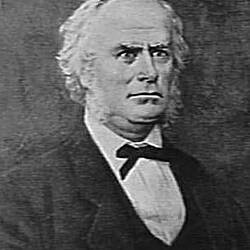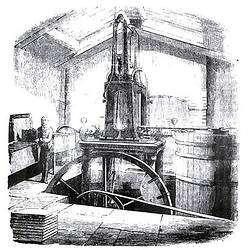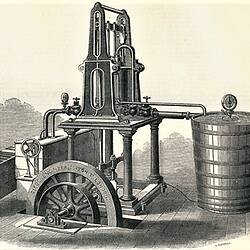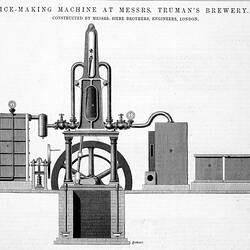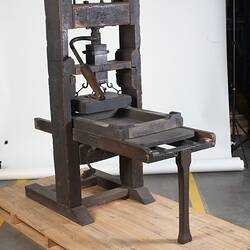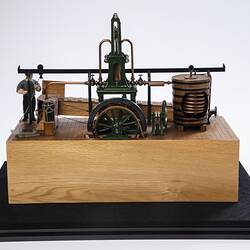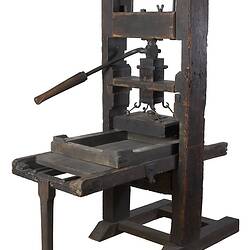James Harrison was born at Bonhill near Renton on the River Leven, Dumbartonshsire, Scotland, in April 1816, the son of William Harrison, a salmon fisherman, and Margaret neé McGregor. After the family moved to Glasgow, James served an apprenticeship with the printer David McClure and attended free evening science classes at Anderson's University. Subsequently he worked as a journeyman printer and clicker in Glasgow and London, before emigrating to Sydney on the Persian in 1837. In Sydney he established a printing and publishing office for James Tegg and worked for a time for several newspapers before moving to Melbourne in 1839, at a time when it was still a small settlement of only 3,000 inhabitants and barely 3 years old. Harrison found employment as a compositor and later editor with the Port Phillip Patriot, the pioneering newspaper founded by John Pascoe Fawkner. When a new printing press arrived at the Patriot office in 1840, Fawkner commissioned Harrison to take his old wooden press to Geelong, then Victoria's second largest town, to establish Victoria's first regional newspaper, the Geelong Advertiser, which released its first weekly issue on 21st November 1840. Subsequently Harrison formed a partnership with John Scamble to purchase the Geelong Advertiser in 1842; and together they also produced a Geelong Almanac, but Harrison soon became sole owner, working as editor, principal journalist and printer.
Although Harrison initially struggled to make the Geelong Advertiser viable, taking on additional work as a jobbing printer and post master, he was well placed to take advantage of the growth of Geelong during the later 1840s and early 1850s, when it became the main port servicing the Ballarat goldfields. Harrison positioned himself as an outspoken advocate for many local issues and was soon also a prominent local businessman, being elected mayor of Geelong in 1850. Harrison served as a member of the Legislative Council for the seat of Geelong from November 1854 until March 1856, prior to his departure for England. Later he served as a member of the Legislative Assembly for Geelong and Geelong West from April 1858 to September 1860.
It was through one of his other business ventures that Harrison first developed the refrigeration invention that would give him enduring fame. Together with local blacksmith, John Scott, he shared a fishing boat venture, which presented them with a problem in how to keep their catch fresh. Experimenting in a small shed at Rocky Point on the banks of the Barwon River, Harrison came up with the world's first compression refrigeration system using sulphuric ether - a substance commonly used as a cleaning fluid in the printing trade - as the refrigerant. By 1855, Harrison had perfected the machine to the point where he was able to produce ice in commercial quantities and applied for a Victorian patent for"an invention of a process and apparatus for refrigerating by the evaporation of volatile liquids in vacuo, their condensation by pressure, and the continued re-evaporation and re-condensation", which was granted in January 1856. The following year in order to commercially develop the invention, Harrison left Australia for Britain where he also applied for patents and formed a partnership with the engineering firm Siebe & Co., of Mason Street, London. The first commercial Harrison-Siebe refrigeration machine was sold in 1857 to a London brewery. Further improvements and sales quickly followed so that by 1861, Harrison refrigeration machines were in use from London and Europe to Peru, Argentina, Calcutta and Sydney.
Harrison returned to Australia in November 1858, to found the Victoria Ice Works in Franklin Street, Melbourne, and arranged for P.N. Russell & Co., of Sydney to manufacture the machines in Australia. He resumed his role as editor of the Geelong Advertiser, which he retained until 1865, although he was forced to sell his financial control of the paper under financial hardship in 1861. By the early 1870s, it was estimated that over 70 Harrison refrigeration units had been built in total and Harrison himself remained involved in further improvements to the design until as late as 1878, but it appears he gains little financial return from the later commercialisation of the design.
Later Harrison worked as a popular science writer for 27 years on the David Syme papers The Age and The Leader, served as both an MLC and MLA in the Victorian parliament and patented a number of other inventions, though none were commercially successful.
References:
Lang, W.R. (1982). James Harrison - Pioneering Genius, Neptune Press Pty Ltd, Newtown, Victoria.
L. G. Bruce-Wallace, 'Harrison, James (1816-1893)', Australian Dictionary of Biography, National Centre of Biography, Australian National University, http://adb.anu.edu.au/biography/harrison-james-2165/text2775, published first in hardcopy 1966, accessed online 28 December 2016.
More Information
-
Keywords
Inventions, Innovation, Mechanical Engineering, Municipal Government, Newspapers, Printing Industry, Refrigeration, Refrigeration Equipment
-
Localities
Geelong, Victoria, Australia, Bonhill, Dumbartonshsire, Scotland, Great Britain, London, England, Great Britain, Paris, France, Bendigo, Victoria, Australia, Melbourne, Victoria, Australia, Adelaide, South Australia, Australia, Sydney, New South Wales, Australia
-
Authors
-
Article types

